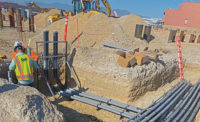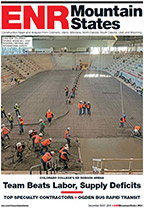"We've found that the approach fosters trust and creates an opportunity for negotiation that otherwise might not have existed. Being forthcoming goes a long way in this cut-throat market, and it has definitely opened doors for us," says Derrick Sander, the company's president.
Buoying hope in the region is the 2012 Colorado Business Economic Outlook, produced by the University of Colorado Boulder's Leeds School of Business. The report, released in early December, forecasts slow, steady growth for the construction market in 2012.
According to the report, the state's construction sector had its fourth consecutive year of employment losses, ending the year with roughly 111,100 jobs, down an estimated 4,000 jobs from the previous year. However, the marginal 3.5% decline signals an upward trend when compared with more dramatic losses in recent years (12.3% in 2010 and 18.9% in 2009).
Should the upswing continue, the state's construction industry will see positive job growth in 2012, with the addition of nearly 3,000 jobs, the report notes.
The number of residential units constructed is expected to grow in 2012, with 9% increase in single-family home permits and a 29% increase in multi-family units. The majority of development is anticipated in Denver and surrounding suburbs.
Nonresidential construction, including office space, institutional development and retail, increased 4.5% in 2011, to $3.1 billion, but this sector remain essentially flat in 2012, at $3.2 billion.
Meanwhile, nonbuilding projects, including transportation construction and power plants, will increase by 7.4% to $2.2 billion. With anticipated declines in tax-based sources and dried up federal ARRA funds, growth in this sector hinges largely on CDOT's plan to increase its construction program by $200 million with newly allocated federal funds and one-time efficiency measures. Nonbuilding project starts for 2012 include three FasTracks commuter lines in the Denver area and bridge repairs through CDOT's FASTER-funded Colorado Bridge Enterprise (CBE).
Moving forward, the general consensus is that the presidential race and evolving political landscape will be a critical factor in the region's recovery pace.
"There's a lot of money sitting on the sidelines right now. The uncertainty and uneasiness of the presidential race and our governmental policies is preventing private developers from moving forward with projects. With so many unknowns, people are waiting around to see what happens next," Hadley says. "One way or the other, the presidential election next year will create the level of predictability needed to stimulate investment."
Contractors' abilities to accommodate different project delivery methods, such as public-private partnership, design-build and fast-track schedules, also prove to be a challenge and an opportunity, Mathisen says.
And most seem to agree that the main hurdle remains access to stable financing for new projects. "There's cheap money out there to be had, but it almost impossible for developers to qualify for financing," Mathisen adds. "That needs to change, sooner rather than later for this recovery to gain momentum."







Post a comment to this article
Report Abusive Comment